Menus
- Monumental machines with plenty of chrome jewelry
- Bowing to the past
- Style meets pleasure
- Indian Chief Vintage with cruise control as standard
- Indian: better cornering feeling despite longer wheelbase
- In the slow range, Harley Softail is easier to control
- Both bikes are motorcycles for haptics
- Data and measured values
- MOTORCYCLE measurements
- MOTORCYCLE conclusion

Gargolov
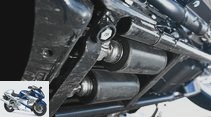

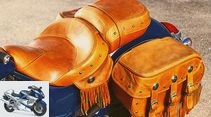
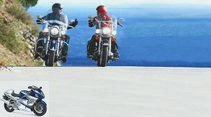
42 photos
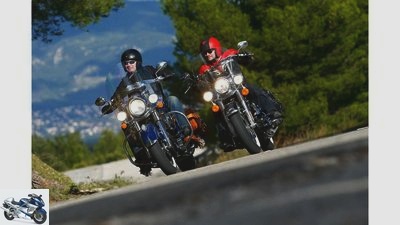
Gargolov
1/42
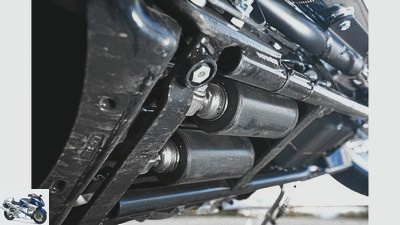
Gargolov
2/42
Its two tension struts work hidden under the gearbox, giving the Softail its rigid frame look. So the Softail goes for a hardtail.
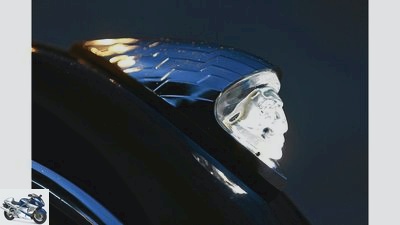
Gargolov
3/42
As beautiful as it used to be: Illuminated Indian head on the front fender, in the same shape and size. They were still original?

Gargolov
4/42
Thick buffalo leather gives the saddles and panniers their charm. The driver’s seat is huge and comfortable, and the space for the passenger is slippery.
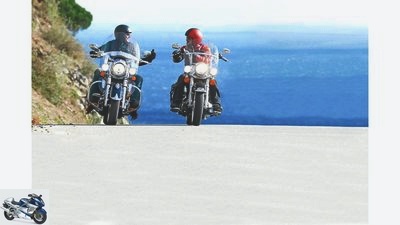
Gargolov
5/42
Both US bikes are really crazy machines – and very nice machines to ride.
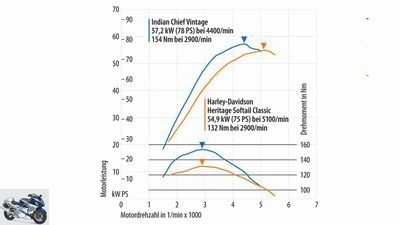
Gargolov
6/42
MOTORCYCLE measurements: Only 121 cm³ separate Indian and Harley.

Gargolov
7/42
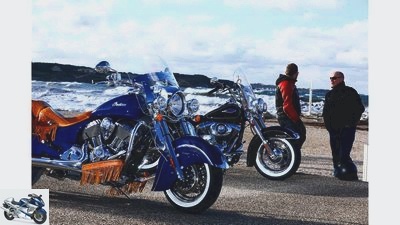
Gargolov
8/42

Gargolov
9/42
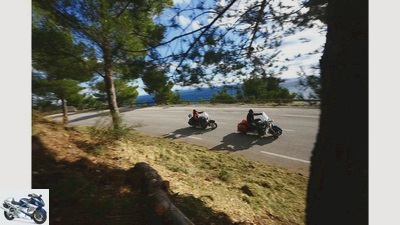
Gargolov
10/42
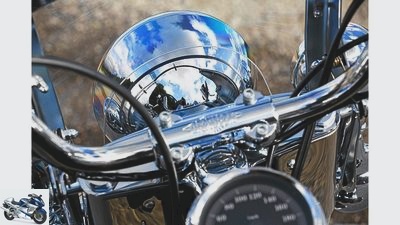
Gargolov
11/42
Between heaven and earth. Only the Harley offers the fascinating experience that the entire environment and the vault of sky curve in the chrome lamp.
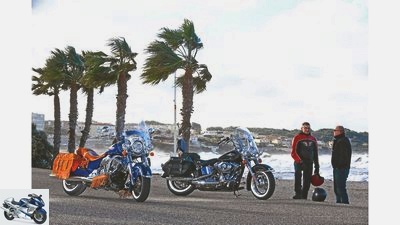
Gargolov
12/42
Against the current. The timeless design of both US bikes is solid as a rock of fast-moving design trends. Icons with whitewall tires on spoked wheels and mighty Big Twins.
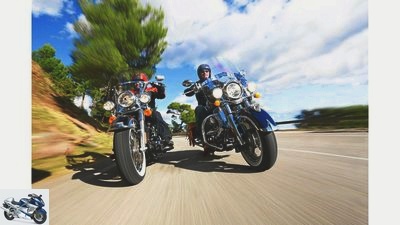
Gargolov
13/42
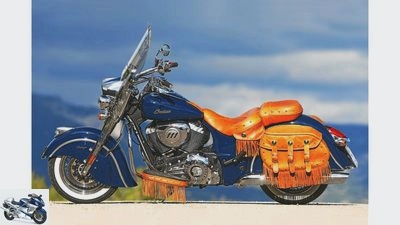
Gargolov
14/42
Brand new. And yet familiar. The lines of the new Indian follow the historic Chiefs from 1940 to 1953, but much larger.
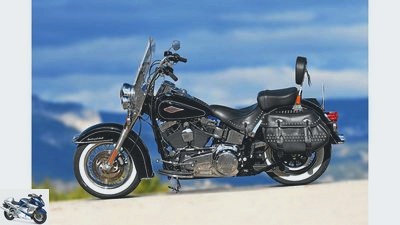
Gargolov
15/42
Form, function, history. The nostalgic design of the Heritage
Softail Classic is said to quote the 1949 Hydra Glide, according to Harley-Davidson.
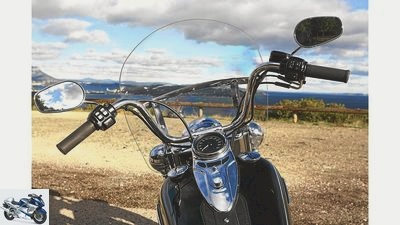
Gargolov
16/42
To Las Vegas, cleaning the sun? OK. The half-height Ape Hanger handlebar is inviting – if you like it.

Gargolov
17/42
One of the most beautiful motorcycle engines has tall cylinders. Behind him in the direction of travel lies the generously chrome-plated, horseshoe-shaped “Horseshoe” oil tank.
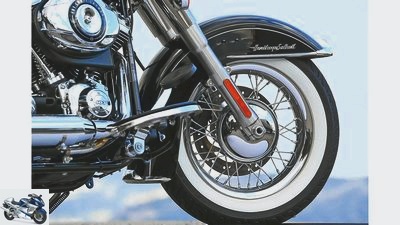
Gargolov
18/42
The bell-shaped cover on the front wheel hub is stylish. However, it requires a single disc.
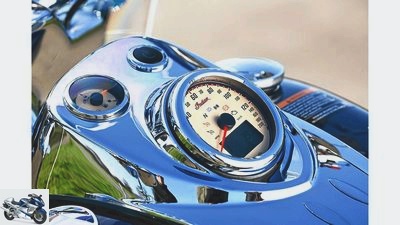
Gargolov
19/42
Not commonplace: speedometer and fuel gauge ivory-colored.

Gargolov
20/42
Monumental engine with bumpers, parallel for each cylinder. Heads shaped like before, when the valves were still on the side.

Gargolov
21/42
Style-defining: curved fenders. They almost reach the wheel axle. The double disc brake with concealed four-piston calipers is effectively anchored.

Gargolov
22/42
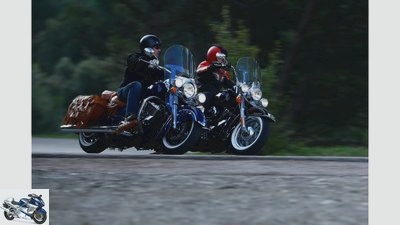
Gargolov
23/42
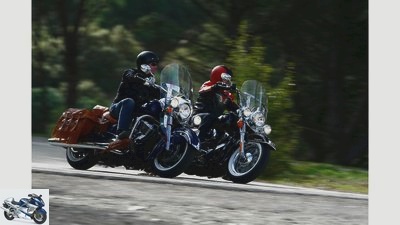
Gargolov
24/42

Gargolov
25/42
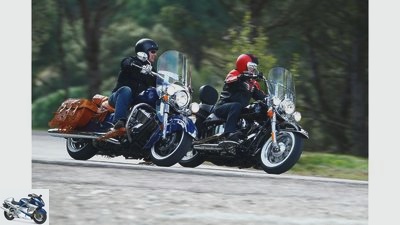
Gargolov
26/42
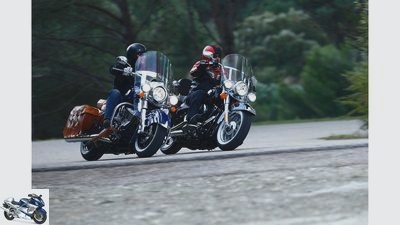
Gargolov
27/42
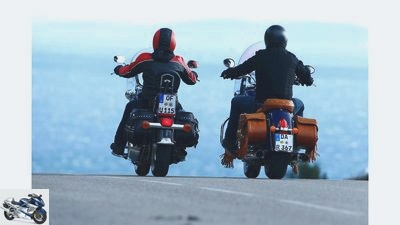
Gargolov
28/42
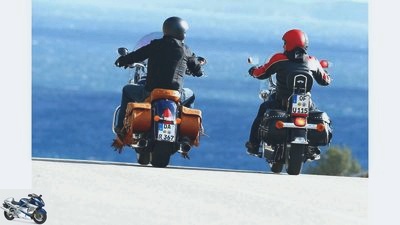
Gargolov
29/42
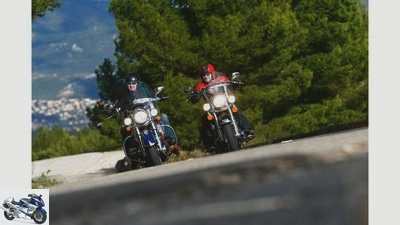
Gargolov
30/42
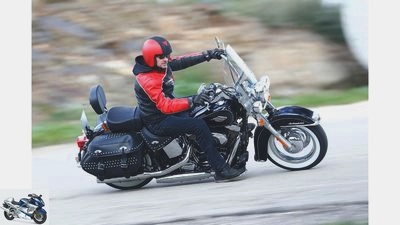
Gargolov
31/42

Gargolov
32/42
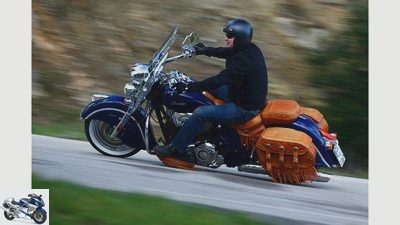
Gargolov
33/42
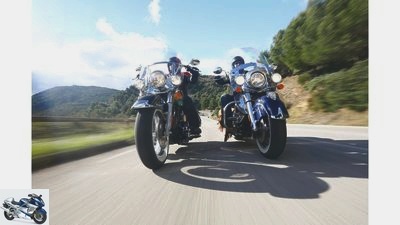
Gargolov
34/42

Gargolov
35/42
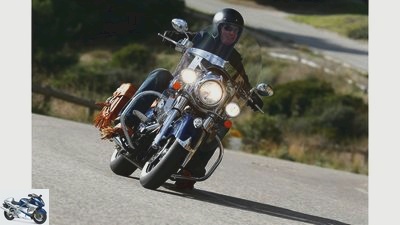
Gargolov
36/42
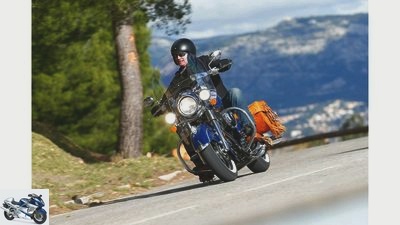
Gargolov
37/42
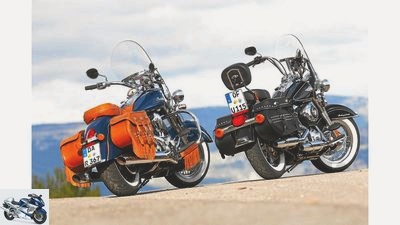
Gargolov
38/42
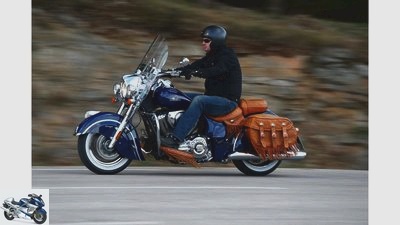
Gargolov
39/42
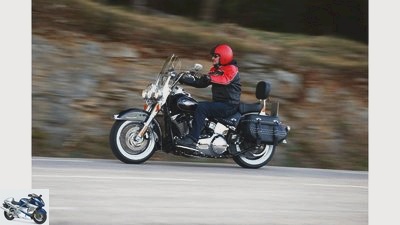
Gargolov
40/42
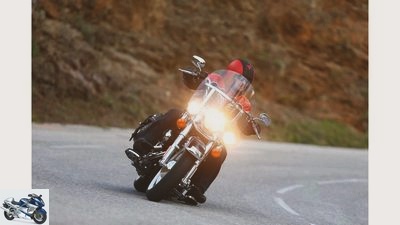
Gargolov
41/42
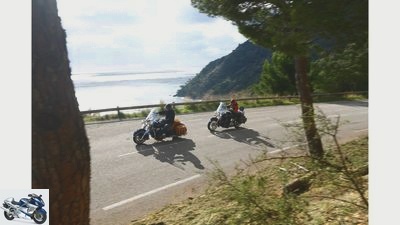
Gargolov
42/42
Harley-Davidson Heritage Softail Classic and Indian Chief Vintage put to the test
Monumental machines with plenty of chrome jewelry
Harley-Davidson Heritage Softail Classic and Indian Chief Vintage spoil with lots of chrome and cathedrals of V2 engines. In addition, the duo is reviving the 110-year-old US feud between Harley-Davidson and Indian.
The Harley-Davidson Heritage Softail and the new Indian rest casually C.said Vintage on their side stands. The old rivalry of traditional US motorcycle brands is back. Indian was America’s first motorcycle manufacturer in 1901. Harley-Davidson appeared in 1903, but has been in production for 110 years. It is not without reason that the Softail Classic bears the suffix “Heritage”. When similar police Harleys escorted US President Kennedy in 1963, Indian had been dead for ten years. But the Indian legend lives on to this day.
Buy complete article
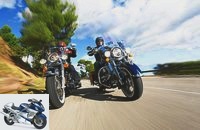
Harley-Davidson Heritage Softail Classic and Indian Chief Vintage put to the test
Monumental machines with plenty of chrome jewelry
Indian Chief Vintage perfectly quote the Chiefs of 1940 and 1953. Harley’s sheet metal fenders look more delicate. Both bikes share a similar philosophy. The traditional, air-cooled, powerful engines are the seat of their soul. Aesthetic technology, technical aesthetics. Internal combustion engines with four bumpers protruding to the right to drive only two valves per cylinder. Maintenance-free by hydraulic valve actuated via camshafts below, two on the Harley-Davidson Heritage Softail, three on the Indian.
Bowing to the past
Gargolov
Against the current. The timeless design of both US bikes is solid as a rock for fast-moving design trends. Icons with whitewall tires on spoked wheels and mighty Big Twins.
The Harley-Davidson Heritage Softail has been spreading its slimmer-looking cylinder at a 45-degree angle to the victory sign since 1909. It’s 49 degrees at Indian Chief Vintage. In historical V-Zwos from 1905 onwards, it was even tighter 42 degrees. The Chief retains the look of the later side-controlled engines: gently rounded heads, characteristic downward manifold. Bowing to the past. Indian’s completely new engine has 1811 cm³, each cylinder almost the size of a beer mug. “Thunder Stroke 111” stands for displacement in cubic inches. The Harley is also a sturdy 1690 cubic meter. Both US icons can be started with the key removed thanks to the immobilizer.
Ignition! Gasoline burns in the heart, a pulse of steel. The Indian Chief Vintage wakes up with a dull growl. Their slightly chubby exhaust sound from extra-long silencers laid on both sides is reminiscent of V8 American sledges. Sonorous and bassy. A nice, even idle with small acoustic set pieces – because of the uneven firing order. The LCD tachometer in the huge round speedometer shows a confident resting heart rate of 750. You can feel a lot of stroke and displacement. Splendid. The Indian sends huge 101 pistons on a 113 millimeter long journey between dead centers. Right in the heart. You think you can feel each piston reversal individually. Like a ship’s diesel. The 1.7 kilogram balance shaft eliminates heavy vibrations.
The Harley-Davidson Heritage Softail offers plenty of good vibrations. It punches and pulsates with life in idle mode. When standing, the V2 stamps impressively, causing the entire front end to tremble. However, the Harley runs at high revs and looks less hardened. Two balance shafts rotate on all Softails, the sparkling V2 is rigidly screwed into the frame. Twin Cam 103 B means, at 103 cubic inches, two cam and balance shafts (“balancers”). 98.4-millimeter pistons have a stroke of 111.1 millimeters in front of them. The Softail sound is subtle when idling. But while driving, she protttttl nice, calming potato, potato. Never chubby, even if the flaps in the air filter and the lower of the two concealed silencers open.
The sun tickles your face under the open face helmet. Tastes salty, the air of the coastal road. The interplay between gas, cable clutch and gearbox works unobtrusively on the Harley-Davidson Heritage Softail. Thanks to the good engine drag torque, it can simply be driven through the accelerator. The Big Twin follows the gas wonderfully smoothly. Like a gently stretched rubber band. The Indian-V2 depends more directly on the gas, load changes slightly harder. Modern: electronically operated throttle valves, 46s for Harley, 54s for Indian. From the start, the chief storms with more force and more thump. Its torque curve in the shape of a buffalo back is shifted compared to the Harley. A maximum of 154 Newton meters at just 2900 tours are compared to 132 of the Harley at the same speed. Well, the Indian Chief Vintage driven here is “Tuning Level 1”: An air throttle in the airbox on the left has been removed. This raises the top performance, which can be registered by appraisal, from officially 75 to a good 84 hp. On the test bench, it is 78 hp after a few run-in kilometers.
Style meets pleasure
Comfortable speed? Everything under 3000. Small speed, great feeling. Both Big Bangers turn less than 2500 tours in sixth gear at 100 km / h. At 50 things, the Harley-Davidson Heritage Softail is still chopping, while the Indian Chief Vintage is already running smoothly. The larger V2 is more elastic. The Softail is long translated to 230. Annoying: an unmistakable ticking from the depths of the Indian engine room, mechanical background noises dominate. Especially the switching processes, with the relentlessness of a railway signal box, the gear wheels find each other.
Here and there, easy-care toothed belts and 16-inch wheels rotate. Whitewall tires on spoked wheels are a matter of honor. Both monumental machines have plenty of chrome jewelry, fringes and rivets. Plus a pair of additional headlights, running boards and leather panniers with camouflaged click fasteners. Together with the disc, they are identification marks of the vintage version of Indians Chief. Every stop is a ceremony. A Harley explains itself. An Indian no less. Style meets pleasure.
Indian Chief Vintage with cruise control as standard
Gargolov
Brand new. And yet familiar. The lines of the new Indian follow the historic Chiefs from 1940 to 1953, but much larger.
Of course, every 500 accelerates better, even pulls faster. 21.6 seconds the Harley-Davidson Heritage Softail from 60 to 140 undercuts any VW Golf. Yes and? That is exactly what the deceleration program is: don’t stress yourself, let yourself be overtaken voluntarily. Cosiness with the power of big hearts. Glide calmly on the Indian Chief Vintage with “Cruise Control”, the standard cruise control. Let the stokers rush through the great landscape all around, carelessly rushing past the most beautiful places. Here, in deep saddles, there is just one motto: see more, experience more. It can stay that way forever. Meditative driving, riding a special iron!
Indian: better cornering feeling despite longer wheelbase
347 Harley kilos clearly undercut 390 kilograms of the Indian Chief Vintage. Uff. Pushing and maneuvering the chief is difficult. Especially since it is more expansive in every dimension – wider, higher and 20 centimeters longer. Long, low, casual? Not when turning. You have to tackle it, 780 pounds need a massive seven meter turning circle. The Harley-Davidson Heritage Softail turns at a civil 5.70 meters. The Indian chassis is much more modern, more precise and more stable. With aluminum frame, progressively hinged strut and 46 instead of 41 fork.
Such road cruisers prefer wide terrain. But in tight corners, the Indian Chief Vintage feels better despite the wheelbase being almost ten centimeters longer. The blue giant turns in easier! The Harley-Davidson Heritage Softail feels heavier, stiffer around the steering head. The Indian is a real street sweeper: First of all, the fringes on the running boards, which are subject to a surcharge, sweep the road. Kehrwoche, the dream of Swabian housewives. Already at roundabouts, the Harley running boards hit hard and creak. That doesn’t sound good at all, passers-by look confused. Cool or embarrassing?
“Accuracy” here does not mean hitting the radius of every curve 100 percent, but the driver’s heart. The Harley-Davidson Heritage Softail is full and creamy as long as the asphalt is good. She is wrapped in cotton wool, feedback is rather weak. Your fork should respond more finely, the tension-loaded struts are underdamped. In addition, the entire chassis is softer, more indifferent, and less precise. All of this makes the wobbly Softail a rocking paddle steamer on mogul slopes. The Indian Chief Vintage does better here. It bounces, filters, and cushions more. And still tells more about what’s going on under you. The Indian sails more confidently through the curves.
In the slow range, Harley Softail is easier to control
Gargolov
Form, function, history. According to Harley-Davidson, the nostalgic design of the Heritage Softail Classic is said to cite the 1949 Hydra Glide.
Together with the potent V2, this leads to an almost inappropriately brisk driving style. Until the Indian Chief Vintage then vigorously pushes out at the corner exit, especially downhill, because 1.73 meters of wheelbase are taking their toll. Phew, then it’s time to grab hold of it to get the Indian back on the right path. When it is wet, the Mammut cruiser turns the tables. Then you will be driven. The Harley-Davidson Heritage Softail is easier to control in the slow range. Even if the Indian is well balanced, it quickly stabilizes itself after driving off.
Because your engine barely brakes, you have to downshift more often on the 1800s. Or brake right away. The double disc with four-piston calipers and good Bosch ABS brakes extremely effectively not only for cruiser conditions. In itself, the Indian brake would be easy to dose. If it weren’t for the strangely kinked, unergonomic brake lever. When braking at the rear, the heel must be off the footboard so that the tip of the foot can reach the steep pedal. Risky: The side stand of the Indian Chief Vintage remains half extended outside. Tamer and with less feedback, the Solo disc anchors in the front wheel of the Harley-Davidson Heritage Softail. Nevertheless, the pure braking values are still okay. High rear wheel load assigns high support to the rear stopper.
Both bikes are motorcycles for haptics
On the Harley-Davidson Heritage Softail, the narrow, half-height Ape Hanger handlebars result in a somewhat indecisive sitting position. There are cooler Harleys. The broad, rubber-mounted Indian handlebar comes far towards the driver. But you sit back a little, far away from the front wheel, and you need long arms when turning. The inviting cowboy saddle made of brown buffalo leather pampers your buttocks. A real Flaz armchair. The Heritage Softail also embeds you on real animal skin. Tall riders hit the steep front edge of the pillion seat with their rump. The Harley offers little space for passengers between the pilot and the standard sissy bar. The rear seat cushion is harder, the passenger pegs are better positioned than on the Indian Chief Vintage. Cozy but extremely slippery: the place behind the chief. That’s how Indians want to get rid of their squaw?
The huge, vertical Indian disk provides full coverage. If it rains, she would need a wiper. But it’s louder behind the smaller Harley windshield, you have the edge in your field of vision. The protective shields of both US cruisers can be removed without tools. What makes the look cleaner.
Turn off the engines again, they continue to crackle for a long time. Thierry, a French “Flic” (sheriff), joins them. He knows everything about the new Indian Chief Vintage, which is too quiet for him. He wants to sell his Harley Street Glide for this. The Indian is more expensive by a hefty 3500 euros. 25,299 euros indicate a lot of self-confidence. The new old American alternative has its own charm and character. Both bikes are motorcycles for haptics, for people who like to touch fine, well-made things that affect quality.
Data and measured values
| Harley-Davidson Heritage Softail Classic | Indian Chief Vintage | |
| ENGINE | ||
| design type |
| Two cylinder four stroke 45 degree V engine |
at 5000 rpm
at 5075 rpm
from steel
minium, motor is supporting
MOTORCYCLE measurements
Gargolov
MOTORCYCLE measurements: Only 121 cm³ separate Indian and Harley.
ENGINE:
Only 121 cm³ separate Indian Chief Vintage and Harley-Davidson Heritage Softail. But with a “dethrottling kit” that can be registered, removing the throttle in the air filter, the Chief clearly outperforms the Softail. The Indian V2 is bearier. Always. Between 2000 and 3500 tours, at the cruising zenith, it easily presses 20 Newton meters more. The Chief achieves the same horsepower output 400 to 1000 tours earlier than the Harley. That is and makes it more casual! Both XXL motors are throttled depending on the gear.
BRAKES:
| Brake measurement from 100 km / h | Remaining speed 28.6 km / h | |||
| Harley-Davidson Heritage Softail Classic | 9.0 m / s² | 42.9 m | ||
| Indian Chief Vintage | 9.8 m / s² | 39.4 m |
Despite the single disc at the front, the Harley-Davidson Heritage Softail achieves a remarkable nine meters / s² braking performance. The 9.8 m / s² of the Indian Chief Vintage are a brilliant achievement: where the 390-kilo colossus comes to a stop when braking from 100 km / h, after 39.4 meters, the Harley rushes through at 29 km / h.
MOTORCYCLE conclusion
Both US bikes are really crazy machines – and very nice machines to ride. The Indian Chief Vintage is a real asset to this class. Looking old has always been a privilege for Harley-Davidson. This could change now. The company could still smile at Victory. And even Indian will not be able to hold a candle to the now overpowering US competitor in terms of quantities. But things are different when it comes to exclusivity and functionality. The new Chief is the better, more modern and more expensive motorcycle. And the more comfortable touring cruiser, at least for taller drivers. So the Harley-Davidson Heritage Softail remains the cheaper, easier to drive and at least just as casual road cruiser. The more masculine motorcycle is the Indian Chief. Indeed, the new chief has what it takes to be a new leader in the cruise class. Howgh!
Related articles
-
Endurance test of the Harley-Davidson Heritage Classic
mps photo studio 16 photos mps photo studio 1/16 On June 6, 2018, the Harley-Davidson Heritage Classic 114 endurance test with 221 km on the clock…
-
Indian Chief Vintage in the 50,000 km endurance test
Gargolov 31 pictures Gargolov 1/31 Froberg 2/31 All horses saddled? Tester Schwers puts the Vintage Chief on the test bench during the input measurement …
-
Harley-Davidson Softail Heritage Classic in the driving report
Harley-Davidson 19 pictures Harley-Davidson 1/19 Exclusive: Of four Softails used, only the Heritage Classic has running boards, a comfortable …
-
Indian Chief from 1946 and Indian Chief Vintage 2014
Gargolov 36 pictures Gargolov 1/36 Revival in the wigwam: Indian is back! Gargolov 2/36 Gargolov 3/36 Gargolov 4/36 Gargolov 5/36 Gargolov 6/36 …
-
Harley-Davidson Road King Classic against Moto Guzzi California 1400 Touring in the test
fact 50 pictures fact 1/50 Moto Guzzi California 1400 Touring fact 2/50 Harley-Davidson Road King Classic against Moto Guzzi California 1400 Touring in …
-
Harley-Davidson Street Glide and Honda Gold Wing F6B put to the test
Gargolov 31 pictures Gargolov 1/31 Front as shortened with a scythe, rear as compressed with a hammer: excavators look strangely pretentious and are in the …
-
Gargolov 50 pictures Gargolov 1/50 The Yamaha XV 1900 A Midnight Star is the only one to brake without ABS, but with a composite system. Gargolov 2/50 Sometimes …
-
Impression – Moto Guzzi California Touring, Indian Springfield and Harley-Davidson Road King Classic
bilski-fotografie.de Impression – Moto Guzzi California Touring, Indian Springfield and Harley-Davidson Road King Classic Westwards Two days free: …
-
Impression: Harley-Davidson Road King Classic and Moto Guzzi California Vintage
Artistic Impression: Harley-Davidson Road King Classic and Moto Guzzi California Vintage There’s only two directions here, boy! With two air-cooled …
-
Cruiser comparison test Harley-Davidson Forty-Eight, Indian Scout, Victory Gunner
Gargolov 24 pictures RG 1/24 RG 2/24 RG 3/24 RG 4/24 RG 5/24 RG 6/24 RG 7/24 RG 8/24 RG 9/24 RG 10/24 RG 11/24 RG 12 / 24 RG 13/24 RG 14/24 RG 15/24 RG 16/24 …